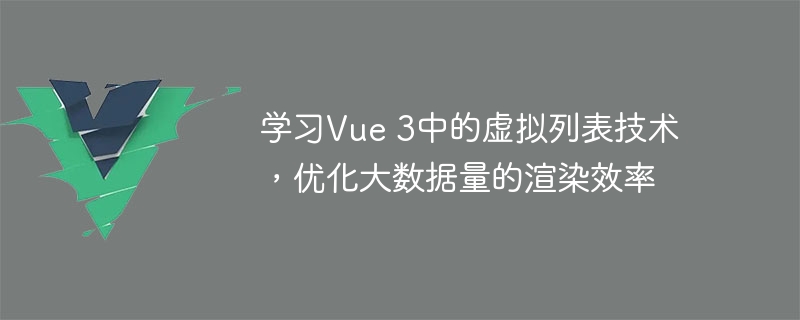

Learn the virtual list technology in Vue 3 and optimize the rendering efficiency of large amounts of data
Introduction:
With the continuous development of front-end technology, more and more A lot of data needs to be rendered and displayed on the front end. When the amount of data is large, traditional rendering methods may cause page rendering to be slow or even stuck. In order to solve this problem, Vue 3 introduced virtual list technology, which can effectively improve the rendering efficiency of large amounts of data. This article will introduce the implementation principle of virtual list technology in Vue 3, and how to use it to optimize the rendering of large amounts of data.
1. What is virtual list technology?
Virtual list technology is a technology that improves rendering efficiency by only rendering data items within the visible area instead of rendering all data items. It is implemented based on the following two principles:
2. Implementation of virtual scroll component in Vue 3
In Vue 3, you can use the <virtual-scroll> component to implement virtual list technology. Here is a simple example:
<template>
<virtual-scroll :items="data" :item-height="40" class="list-container">
<template v-slot="{ item }">
<div class="list-item">{{ item }}</div>
</template>
</virtual-scroll>
</template>
<script>
import { VirtualScroll } from "vue-virtual-scroll";
export default {
components: {
VirtualScroll,
},
data() {
return {
data: [], // 大数据集
};
},
mounted() {
// 在mounted钩子函数中模拟获取大数据集
this.data = Array.from({ length: 10000 }, (_v, i) => `Item ${i+1}`);
},
};
</script>
<style scoped>
.list-container {
height: 400px;
overflow-y: auto;
}
.list-item {
height: 40px;
line-height: 40px;
}
</style>In the above example, we used the <virtual-scroll> component to implement a virtual list. It accepts two key attributes: items and item-height. items is an array containing all data items, and item-height represents the height of each data item. Inside <template> we use the v-for directive to iterate through the data items and render each one.
In the mounted hook function, we simulated obtaining a large data set containing 10,000 data items and assigned it to the data attribute. When the <virtual-scroll> component is rendered, only data items located within the visible area will be rendered, and new data items that appear will be dynamically rendered based on the scroll position.
By using virtual list technology, the rendering effect of the page can be maintained well even if the amount of data is large.
3. Conclusion
Virtual list technology is well supported in Vue 3 and can be used to optimize the rendering efficiency of large amounts of data. By only rendering data items within the visible area, virtual list technology effectively reduces the rendering workload and improves the rendering performance of the page. In actual development, when large amounts of data need to be rendered, you can consider using the virtual list technology in Vue 3 to optimize rendering efficiency.
I hope this article will help you understand the virtual list technology in Vue 3!
The above is the detailed content of Learn the virtual list technology in Vue 3 and optimize the rendering efficiency of large data volumes. For more information, please follow other related articles on the PHP Chinese website!